Credit Collapse Financial Market Impacts and Implications
Stock-Markets / Credit Crisis 2008 Dec 18, 2008 - 06:35 PM GMTBy: Doug_Wakefield

 The Big, the Bull, and the Bankers - Over the last few years, in my search to understand how we arrived at this historic juncture, I have been confronted with how ignorant the general public is regarding the history of money. But, after five years of researching and writing about this period, I still find it difficult to understand the day-to-day machinations of things like Collateral Debt Obligations, Credit Default Swaps, and Currency Swaps. So, the public's confusion is understandable. Bundling hundreds of debt products and layering them one on top of other, as collateral, is just too complex. But, I am not alone in this.
The Big, the Bull, and the Bankers - Over the last few years, in my search to understand how we arrived at this historic juncture, I have been confronted with how ignorant the general public is regarding the history of money. But, after five years of researching and writing about this period, I still find it difficult to understand the day-to-day machinations of things like Collateral Debt Obligations, Credit Default Swaps, and Currency Swaps. So, the public's confusion is understandable. Bundling hundreds of debt products and layering them one on top of other, as collateral, is just too complex. But, I am not alone in this.
Apparently, the largest pools of institutional money in the world are just as clueless about these highly complex, multi-billion dollar debt products, which they purchased for company pensions, insurance concerns or global foundations, as retail investors are about the inner workings of their mutual funds. It's as if, as long as someone has told them it will work, it has to work.
In looking at several charts over the last few days, we look to be nearing the point where adding one more grain to the sandpile could easily start an avalanche. And, since neither I nor anyone wants to see an avalanche, we must deal with our emotions and look at science and history.
First, let's address our fears: we are all watching something that we are told cannot take place. But the situation has continued to escalate, since the summer of 2007, such that it likely will take place. Yet, whether we are retail investors or US Senator, our denial of the probable persists. Why? Plainly, the alternative is just too painful to consider. In his book, The Wave Principle of Human Social Behavior and the New Science of Socionomics, Robert Prechter explains:
“The limbic system has the capacity to generate out of context, affective feelings of conviction that we attach to our beliefs regardless of whether they are true or false. In normal people, too, feelings of certainty can be so overwhelming that they stand fast in the face of logic and contradiction.”
If we can move past cognitive dissonance and explore that which causes us fear, we can begin to understand the series of events that continues to unfold, and as the parts begin to form the whole, our understanding grows. But, while the inter-related pattern unfolds around us, many traders and experts interpret each days moves within the confines of the daily set of events. Needless to say, this type of analysis causes its hearers to lose sight of the bigger picture.
And though it is true that we have never lived through a set of circumstances like today, history rhymes, science draws the parameters, and mankind – regardless of race, age, religious beliefs, or nationality – has not changed. We display the same fear, greed, love and hate, as we have throughout history. While we have made many technological advancements, we display the same emotions as those living 1000, 2000, of even 4000 years ago.
The Big
Now, if you agree with my premise to this point, consider the following charts, and see if you see what I see from the trading activity in the top currencies of the world.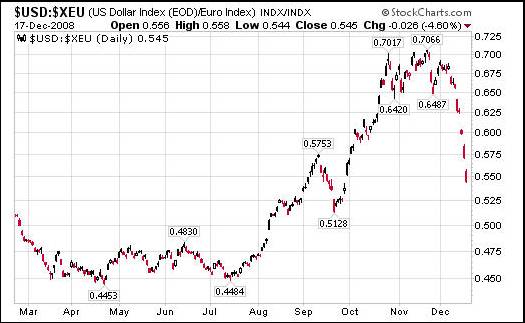
The wide volatility in these major currencies must be wreaking havoc on the real world operations of global corporations and banks, and governments around the world.
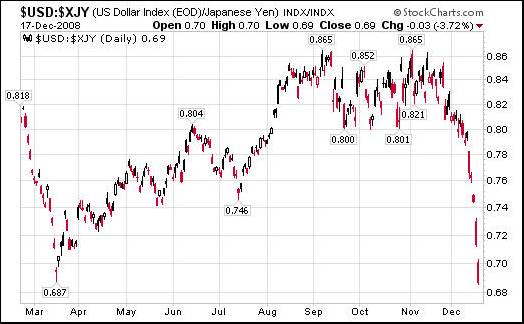

To further drive home the ramifications of these violent currency moves, consider the following, taken from the Foreign Exchange Market educational page of the Federal Reserve Bank of New York:
“To buy foreign goods or services, or to invest in other countries, companies and individuals may need to first buy the currency of the country with which they are doing business. Generally, exporters prefer to be paid in their country's currency or in U.S. dollars, which are accepted all over the world.
When Canadians buy oil from Saudi Arabia they may pay in U.S. dollars and not in Canadian dollars or Saudi riyals, even though the United States is not involved in the transaction.
The foreign exchange market, or the " FX " market, is where the buying and selling of different currencies takes place. The price of one currency in terms of another is called an exchange rate .
The market itself is actually a worldwide network of traders, connected by telephone lines and computer screens—there is no central headquarters. There are three main centers of trading, which handle the majority of all FX transactions—United Kingdom, United States, and Japan.
Transactions in Singapore, Switzerland, Hong Kong, Germany, France and Australia account for most of the remaining transactions in the market. Trading goes on 24 hours a day: at 8 a.m. the exchange market is first opening in London, while the trading day is ending in Singapore and Hong Kong. At 1 p.m. in London, the New York market opens for business and later in the afternoon the traders in San Francisco can also conduct business. As the market closes in San Francisco, the Singapore and Hong Kong markets are starting their day.
The FX market is fast paced, volatile and enormous—it is the largest market in the world. In 2001 on average, an estimated $1,210 billion was traded each day—roughly equivalent to every person in the world trading $195 each day.”
When the Dollar is down 15% against the Yen, 16% against the Pound, and 20% against the Euro, in nine trading days, we must consider the fact that these result in operational changes, tied to profits and losses, worldwide. While the dollar rebounded today, global businesses and world leaders have a much more difficult task in making long-term projections in the midst of such volatile currencies. How will this impact their next quarter's earnings or their cash flows? At this level of instability, the last few weeks must have had enormous operational impacts.
The Bull
In reading Steve Hochberg's (of Elliottwave International) Daily Update, his comments on the historic nature of these moves stuck out:
“The [March U.S. 30-year Treasury Bond] never tripped our cited “trigger” level for a bearish stance (a break of 132-09), which kept us out of this market. Yesterday's price surge was historic in that it is the first time ever that the Daily Sentiment Index of bond traders pushed to 99% bond bulls (see chart). Only 1% of bond traders think prices will come down, which is simply extraordinary. When everyone is bullish, and in this particular case everyone really IS bullish, there is theoretically no one left to buy in order to keep the trend intact, which leads to a reversal.”
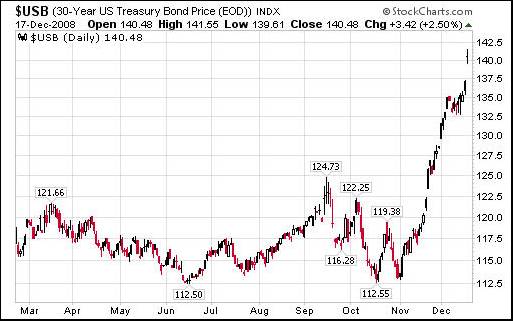
Did the Fed's latest decision to cut rates on December 16th cause bond investors to react any differently than they have since August 2007?
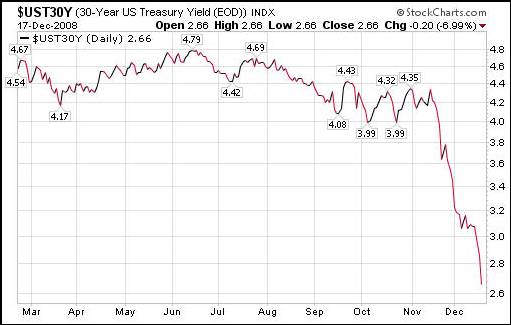
Did the wording found in the Fed's announcement tell bond investors they should change their belief that the Fed can play this game indefinitely?
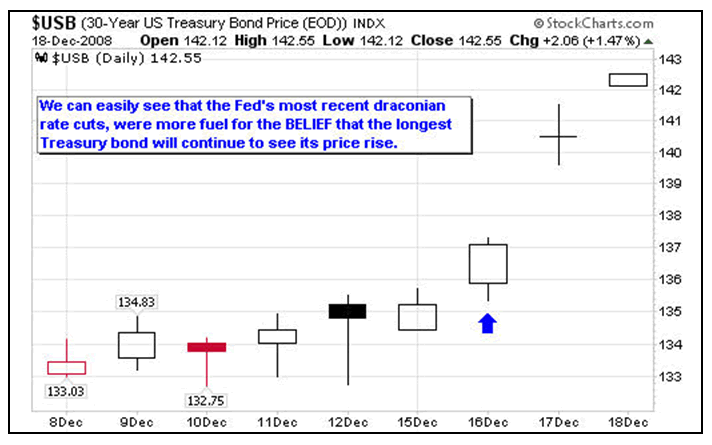
“As previously announced, over the next few quarters the Federal Reserve will purchase large quantities of agency debt and mortgage-backed securities to provide support to the mortgage and housing markets, and it stands ready to expand its purchases of agency debt and mortgage-backed securities as conditions warrant. The Committee is also evaluating the potential benefits of purchasing longer-term Treasury securities ” [Federal Reserve Governor's Press Release , December 16, 2008]
What will happen to credit markets when the spike in price comes to an end, yields start to rise, rather than fall, thus impacting borrowing costs around the globe?
What also hit me about Hochberg's comment on the historic number of bulls in the long end of the Treasury markets, were the similarities that this group of individuals had with wheat farmers in the 1920s. Farmers in the 1920s had seen the government intervene for years trying to prop up the price of wheat. In their belief in the omnipotent Fed, they continued to borrow money from one government agency and sell to another. The more the role of government expanded, the stronger the belief that it could always expand.
Our March 28 '08 Short Report to our subscribers addressed the similarities between the events in the 1920s, to those unfolding currently. We relied heavily on Dr. Murray Rothbard's work, “The History of Money and Banking in the United States”. Fortunately for us today, their have been those in the 20th century, who felt it their moral duty to leave the next generation as accurate an historical record as possible.
“Since we are all familiar with what happened in the stock market crash of 1929, and the ensuing collapse of equity prices in the next 3 years, let us return to our discussion on commodity prices, which directly led to the picture and comments from FDR, found in our July 2007 issue. In the weeks leading up to the market Crash of 1929, the newly found government-lending machine, the Federal Farm Board (FFB), was moving to “stabilize” wheat prices.
To try and hold up wheat prices by keeping some of the supply of wheat off the market, on October 26 th of 1929, the FFB announced it would lend $150 million for wheat crops at up to 100 percent of the market price. As prices continued to fall in 1929, the FFB created another government agency – the Farmer's National Grain Committee (FNGC), which aimed to centralize all farmers' grain cooperatives and eliminate competition among them. While this was supposed to stabilize wheat prices, it only made matters worse.
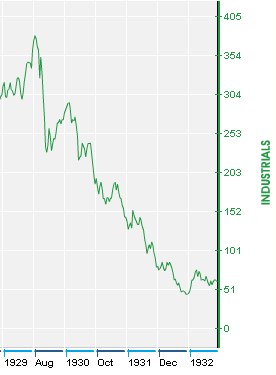 By the middle of 1931, the Grain Stabilization Corporation, which replaced the 1929-formed FNGC, was authorized to purchase as much wheat as possible. Even after increasing their purchases by an additional 200 million bushels, prices continued to collapse. The larger FFB eventually threw in the towel, and dumped their wheat stocks, resulting in a final collapse.
By the middle of 1931, the Grain Stabilization Corporation, which replaced the 1929-formed FNGC, was authorized to purchase as much wheat as possible. Even after increasing their purchases by an additional 200 million bushels, prices continued to collapse. The larger FFB eventually threw in the towel, and dumped their wheat stocks, resulting in a final collapse.
Though the American farmer had never seen anything like this, our national government sought every means to intervene to save our markets. Congress passed act upon act, extending money through the alphabet soup of agency acronyms. And just like today, though it could not stem the flow of crashing prices, it did affect the lives of all who depended upon the commodities that farmers bring to market for our basic food supply.
But surely, the bust that occurred in commodity prices in the early 1920s had nothing to do with a fallacious banking system. Surely, if we join hands with the government, we will find a “better” solution. Just like with cotton, these brilliant central planners told farmers not to send their wheat to market too rapidly, but to hold the wheat and wait for higher prices. Like so many funds that have suspended redemptions, regarding their $465 million in CDOs and CLOs, two weeks ago ING's stated : “To continue to allow withdrawals to satisfy a minority of investors could significantly reduce the quality of the portfolio.”
The Bankers
The game of flooding paper money to key players while telling other they are not worthy of a bailout, has undoubtedly made us all leery of hearing statements like that concerning Goldman Sachs , “first quarterly loss in nine years since going public,” or Morgan Stanley , “revenues in every corner of the bank fell, even when compared with last quarter, showing a deteriorating environment that cut across business,” and then watching their prices climb.
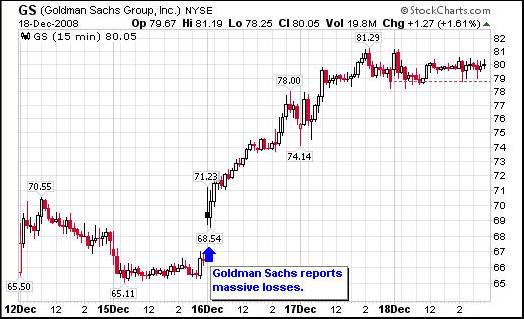
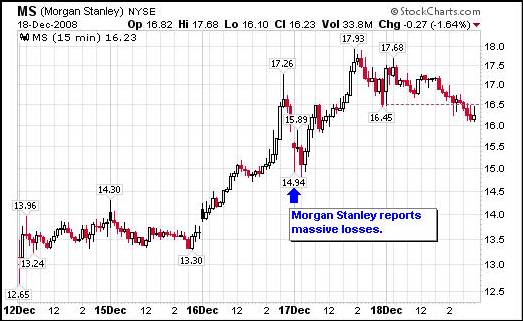
Since the day-to-day price moves of our leading financial firms defy common sense, I have found that watching the larger indices that are harder to manipulate more reliable. The following is a chart I presented to our subscribers on Tuesday, after the Federal Reserve's announcement and the subsequent explosive rally.
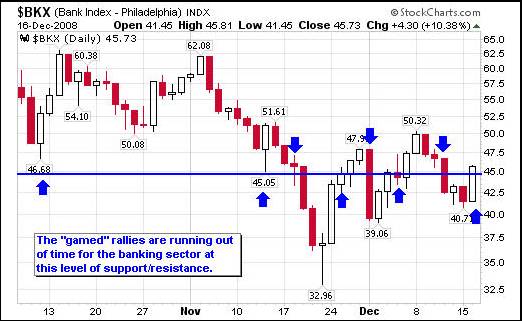
This next chart shows the same index two days later.
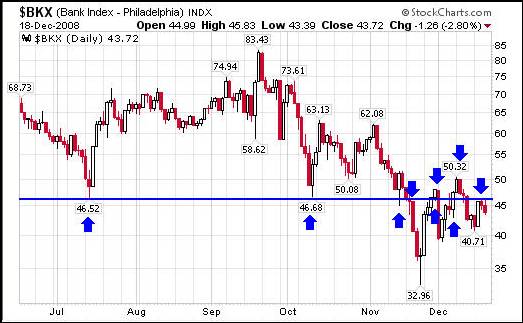
So, what could science tell us about the extreme swings in the dollar in under two weeks, the most daily bullish sentiment reading on record in the 30 year bond, and the increasing frequency of the banking sector's attempts to rise above its longer-term resistance level over the last month? Physicist Mark Buchanan gives us a glimpse in his book, Ubiquity :
“Earthquakes in the real world tend to be accompanied by foreshocks and aftershocks, which is another way of saying that large earthquakes tend to cluster together in time, and that the longer you wait without seeing one, the longer you will probably have to wait.”
And the reverse is also true; the faster events cluster together and the more violent the swings in both directions, the stronger the likelihood of an earthquake.
Conclusion
Next week is Christmas and the one following New Years, so I really don't even want to consider the ramifications of this report. But, I continue to believe that it is better for me to test my theories against the backdrop of history, science, and human nature, than to trust in “experts,” myself included, bold political agendas, or solely in the past track record of successful money managers. We have been in a credit contraction since the summer of 2007, so we must consider all our decisions in light of this new world environment. In my opinion, something of historical significant is once again knocking at our door.
If you are interested in learning what you are missing from listening to the daily news without a historical perspective, consider joining our group of worldwide readers. To subscribe to our research, click here . To learn more about our research and advisory services, click here .
A current subscription to our research gains an individual access to all of our educational writings, back to January 2006, as well as our industry research paper on short selling, Riders on the Storm: Short Selling in Contrary Winds.
By Doug Wakefield with Ben Hill,
President
Best Minds Inc. , A Registered Investment Advisor
3010 LBJ Freeway
Suite 950
Dallas , Texas 75234
doug@bestmindsinc.com
phone - (972) 488 -3080
alt - (800) 488 -2084
fax - (972) 488 -3079
Copyright © 2005-2008 Best Minds Inc.
Best Minds, Inc is a registered investment advisor that looks to the best minds in the world of finance and economics to seek a direction for our clients. To be a true advocate to our clients, we have found it necessary to go well beyond the norms in financial planning today. We are avid readers. In our study of the markets, we research general history, financial and economic history, fundamental and technical analysis, and mass and individual psychology.
Disclaimer: Nothing in this communiqué should be construed as advice to buy, sell, hold, or sell short. The safest action is to constantly increase one's knowledge of the money game. To accept the conventional wisdom about the world of money, without a thorough examination of how that "wisdom" has stood over time, is to take unnecessary risk. Best Minds, Inc. seeks advice from a wide variety of individuals, and at any time may or may not agree with those individual's advice. Challenging one's thinking is the only way to come to firm conclusions.
Doug Wakefield Archive |
© 2005-2022 http://www.MarketOracle.co.uk - The Market Oracle is a FREE Daily Financial Markets Analysis & Forecasting online publication.


